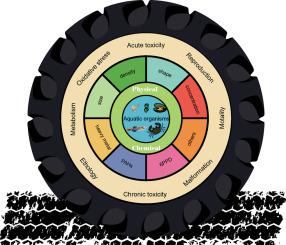当前位置:
X-MOL 学术
›
Aquat. Toxicol.
›
论文详情
Our official English website, www.x-mol.net, welcomes your
feedback! (Note: you will need to create a separate account there.)
Tire and road wear particles in the aquatic organisms – A review of source, properties, exposure routes, and biological effects
Aquatic Toxicology ( IF 4.1 ) Pub Date : 2024-06-21 , DOI: 10.1016/j.aquatox.2024.107010 Tianyu Zhao 1 , Yun Zhang 1 , Qianqian Song 1 , Qingxuan Meng 1 , Siyu Zhou 1 , Jing Cong 1
Aquatic Toxicology ( IF 4.1 ) Pub Date : 2024-06-21 , DOI: 10.1016/j.aquatox.2024.107010 Tianyu Zhao 1 , Yun Zhang 1 , Qianqian Song 1 , Qingxuan Meng 1 , Siyu Zhou 1 , Jing Cong 1
Affiliation

|
With the continuous development of the modern social economy, rubber has been widely used in our daily life. Tire and road wear particles (TRWPs) are generated by friction between tires and the road surface during the processes of driving, acceleration, and braking. TRWPs can be divided into three main components according to their source: tire tread, brake wear, and road wear. Due to urban runoff, TRWPs flow with rainwater into the aquatic environment and influence the surrounding aquatic organisms. As an emerging contaminant, TRWPs with the characteristics of small particles and strong toxicity have been given more attention recently. Here, we summarized the existing knowledge of the physical and chemical properties of TRWPs, the pathways of TRWPs into the water body, and the exposure routes of TRWPs. Furthermore, we introduced the biological effects of TRWPs involved in size, concentration, and shape, as well as key toxic compounds involved in heavy metals, polycyclic aromatic hydrocarbons (PAHs), N-(1,3-dimethylbutyl)-N’-phenyl-p-phenylenediamine (6PPD), and benzothiazole on aquatic organisms, and attempted to find the relevant factors influencing the toxic effects of TRWPs. In the context of existing policies that ignore pollution from TRWPs emissions in the aquatic environment, we also proposed measures to mitigate the impact of TRWPs in the future, as well as an outlook for TRWPs research.
中文翻译:

水生生物中的轮胎和道路磨损颗粒 - 来源、特性、暴露途径和生物效应综述
随着现代社会经济的不断发展,橡胶已广泛应用于我们的日常生活中。轮胎和道路磨损颗粒(TRWP)是在行驶、加速和制动过程中轮胎与路面摩擦产生的。 TRWP 根据其来源可分为三个主要组成部分:轮胎胎面、制动磨损和道路磨损。由于城市径流,TRWP随雨水流入水生环境,影响周围水生生物。 TRWPs作为一种新兴污染物,具有颗粒小、毒性强的特点,近年来受到越来越多的关注。在此,我们总结了TRWPs的物理和化学性质、TRWPs进入水体的途径以及TRWPs的暴露途径的现有知识。此外,我们还介绍了TRWP在尺寸、浓度和形状方面的生物效应,以及重金属、多环芳烃(PAHs)、N-(1,3-二甲基丁基)-N'-苯基等关键有毒化合物。研究了对苯二胺(6PPD)和苯并噻唑对水生生物的影响,并试图寻找影响TRWPs毒性作用的相关因素。在现有政策忽视TRWPs排放对水生环境污染的背景下,我们还提出了未来减轻TRWPs影响的措施,以及TRWPs研究的展望。
更新日期:2024-06-21
中文翻译:

水生生物中的轮胎和道路磨损颗粒 - 来源、特性、暴露途径和生物效应综述
随着现代社会经济的不断发展,橡胶已广泛应用于我们的日常生活中。轮胎和道路磨损颗粒(TRWP)是在行驶、加速和制动过程中轮胎与路面摩擦产生的。 TRWP 根据其来源可分为三个主要组成部分:轮胎胎面、制动磨损和道路磨损。由于城市径流,TRWP随雨水流入水生环境,影响周围水生生物。 TRWPs作为一种新兴污染物,具有颗粒小、毒性强的特点,近年来受到越来越多的关注。在此,我们总结了TRWPs的物理和化学性质、TRWPs进入水体的途径以及TRWPs的暴露途径的现有知识。此外,我们还介绍了TRWP在尺寸、浓度和形状方面的生物效应,以及重金属、多环芳烃(PAHs)、N-(1,3-二甲基丁基)-N'-苯基等关键有毒化合物。研究了对苯二胺(6PPD)和苯并噻唑对水生生物的影响,并试图寻找影响TRWPs毒性作用的相关因素。在现有政策忽视TRWPs排放对水生环境污染的背景下,我们还提出了未来减轻TRWPs影响的措施,以及TRWPs研究的展望。











































 京公网安备 11010802027423号
京公网安备 11010802027423号